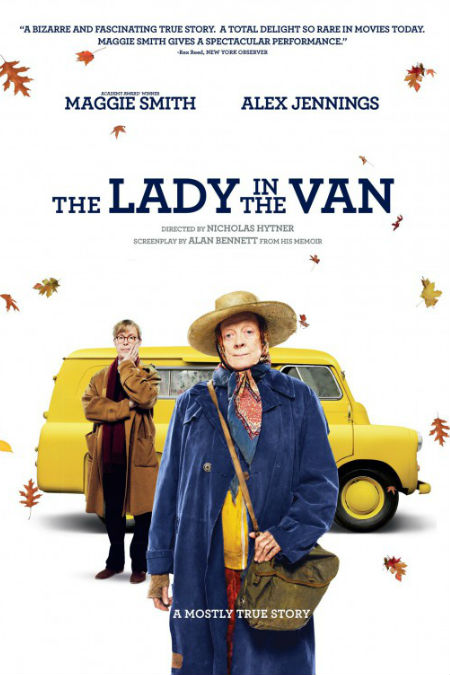
If you’ve ever been tempted to judge someone based on their appearance or current circumstance, The Lady in the Van is an instructive lesson on the pitfalls of such a judgement approach.
Based on the true story of British playwright Alan Bennett’s (Alex Jennings) fractious friendship with van-dwelling homeless woman Mary Shepherd (Maggie Smith, reprising her much-acclaimed stage performance), and directed by Nicholas Hytner from a screenplay by Alan Bennett, the film is a richly-realised, gently-meandering reminder that there is always more to a person’s life than meets the eye.
When Bennett first encounters Shepherd she is a grimy, irascible deluded homeless woman who believes God, angels and a host of saints are providing her with life advice on everything from parking to where she should live; as the story develops however we discover that the woman occupying prime real estate in Gloucester Street, Camden in London was a talented pianist, a former pupil of the legendary Alfred Cortot who, after a particularly traumatic life event, found herself unable to return to the life she’d once known.
Shepherd, it emerges, was just a broken woman of very set ideas who saw herself as a sinner, a failure who could never atone for the great sins of her past, one in particular haunting her constantly, and who thus kept herself on the run, emotionally and physically from the ghosts of her past.
Thankfully being a British film, The Lady in the Van is not afflicted by the treacly sentimentalism that often sinks Hollywood’s efforts at addressing stories of this ilk, preferring to keep things alternately prickly and sweet, but most the former recognising that that extraordinary friendships between people like Bennett and Shepherd are never perfect and often far from inspiring, as are the people themselves.
They simple are, warts and all, and Bennett, who spent 15 years hosting Shepherd and her van in his home’s driveway, to little to no thanks – amusingly Shepherd greets everything from Christmas presents from the neighbours to often of food and toilet use with a sense of grouchy entitlement – moved between being glad he could help Shepherd out and resenting her enduring presence on his property.
While the focus is most certainly on Shepherd and her backstory, which emerges in judiciously placed, well-told fashion that fleshes out her present without disconnecting us from current events, we’re also witness to Bennett’s sense of personal dissociation.
Effectively in the closet, although all his neighbours bar one sweetly naive lady who enthusiastically asks everyone one night when they’re going to find Bennett a female partner, his sense of alienation from himself and palpable discomfort with life is evidenced by the neat visual trick of having Jennings play the two parts of the playwright, often in the same scene.
Bennett the writer and Bennett the one who lives life – reluctantly it seems with the preference being to stay ensconced writing at a window-side table whenever possible – engage in conversations that vividly illustrate how he wrestled with not just Shepherd’s presence in his life, but also his own ability to deal with the business of living, particularly his gently fraught relationship with his loving but opinionated mother.
A kind man at heart who simply can’t bear to leave Shepherd to her own devices, even though you can tell at times he really wishes he could, Bennett is a man benignly at war with himself, who veers between kindness and exasperation, affection and distaste, depending on how many buttons Shepherd has managed to push on a given day.
And button-pushing, even with those who supported her, such as Bennett’s liberal-leaning, well-off neighbours who tolerate the van lady because she makes them feel better about their prosperity and their disposal of it, was an artform that Shepherd has raised to the highest level.
For all that irascibility however, she and Bennett, both their flaws and their character strengths on full display, come across as wholly sympathetic, likeable characters, people who are simply trying to deal with life in as painless a way as possible.
And that’s likely why, despite their combative relationship, they stayed living so close together for as long as they did.
For all the butting of heads, they were essentially birds of a feather, both of them in their quite disparate ways, ill-at-ease with life and not really certain of where they belonged in its rich tapestry of possibilities.
With only the odd appearance of the real life Bennett in the final scene, evoking of all things reality’s hilarious intrusion at the end of Monty Python and the Holy Grail, to mar its nuanced, uncomplicated narrative, The Lady in the Van is sweet, funny, all too relatable and real, the evocation of a friendship that endured despite a whole host of reasons why it shouldn’t.
It doesn’t seek to sanitise either Bennett or Shepherd, nor does it seek to dramatise what happened between them in the hopes of drawing out some sage lessons of not judging by appearance online.
Rather it simply tells its story, in so doing making it all too clear that life doesn’t always play by the rules we would like it to, and that there aren’t always happy endings, or at least of the type that Disney favours, and that often we simply have to make do the best we can.
What is so remarkable about Bennett and Shepherd’s story is that neither of them is utterly, inspiringly transformed by their unconventional friendship; certainly they change in small ways, and in Bennett’s case a major way, towards the end, but what The Lady in the Van most clearly demonstrates is that life often just happens and we are neither better or poorer for it, simply different and that we shouldn’t overthink it, we should just do it and see where it takes, warts and all.